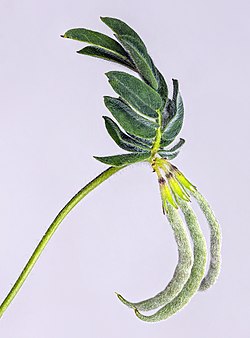| Ornithopus | |
|---|---|
 | |
| Ornithopus perpusillus | |
| Scientific classification | |
| Kingdom: | Plantae |
| Clade: | Tracheophytes |
| Clade: | Angiosperms |
| Clade: | Eudicots |
| Clade: | Rosids |
| Order: | Fabales |
| Family: | Fabaceae |
| Subfamily: | Faboideae |
| Tribe: | Loteae |
| Genus: | Ornithopus L. (1753) |
| Species | |
See text | |
| Synonyms [1] | |
OrnithopodiumMill. (1754) | |
Ornithopus, the bird's-foot, [2] is a genus of flowering plants in the legume family, Fabaceae. It includes six species and one natural hybrid native to Europe, Macaronesia, the eastern Mediterranean, northwest Africa, and Iran, and from southern Brazil to northeastern Argentina in South America. [1]

- Ornithopus × bardiei Jeanj.
- Ornithopus compressus L. — yellow serradella
- Ornithopus micranthus (Benth.) Arechav.
- Ornithopus perpusillus L. — little white bird's foot
- Ornithopus pinnatus (Mill.) Druce — orange bird's foot
- Ornithopus sativus Brot. — serradella, common bird's foot
- Ornithopus uncinatus Maire & Sam.